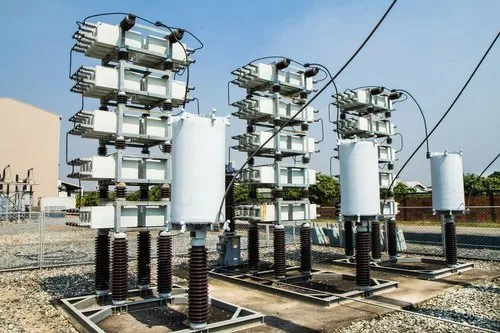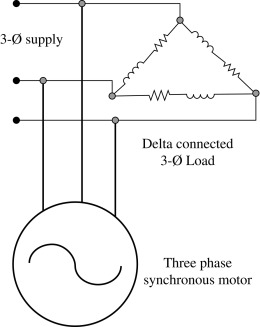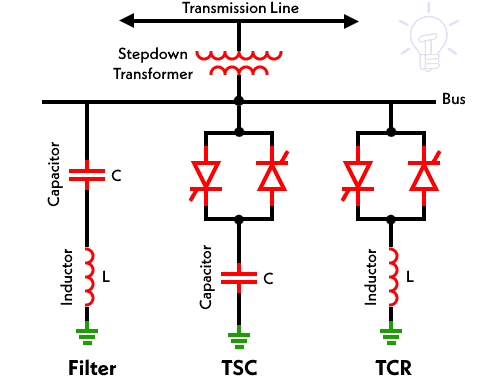We know that electrical power has two components-Real power(W) and Reactive power (VAR) .Reactive power compensation improves system voltage levels, enhances grid stability margins, reduces line losses and results in economic benefits. Reactive power is defined as the amount of power that remains unused and gets generated within an AC circuit or system by the reactive components. This is also
sometimes called imaginary power.
Proper management of reactive power in a power system leads to improvement in the performance of A/c power systems. In present scenario, the reactive power is compensated by widely used Capacitor banks.
REACTIVE POWER IN POWER SYSTEM
Reactive power is considered an essential part of power system but it is seen as a major hurdle in getting a quality power and a consistent voltage. The source of reactive power can be anything from inductive loads, peak load, power theft or connection of various distribution generation units to the grid.
The demand for this reactive power mainly originates from the inductive load connected to the system. These inductive loads are generally electromagnetic circuits of electric motors, electrical transformers, the inductance of transmission and distribution networks, induction furnaces, fluorescent lightings, etc. This reactive power should be properly compensated otherwise, the ratio of actual power consumed by the load, to the total power i.e. vector sum of active and reactive power, of the system will become quite less. This ratio is alternatively known as the electrical power factor, and a lower ratio indicates a poor power factor of the system.
Compensation has two aspects:
(a) Load Compensation which increases the power factor, balance the real power drawn, compensate voltage regulation and eliminate current harmonics of the system.
(b) Voltage Support decreases the voltage fluctuation at any given terminal of a transmission line. Therefore, Reactive power (VAR) compensation improves the stability of ac system by increasing the maximum active power which can be transmitted.
Methods of Reactive Power Compensation:
A low value of power factor requires large reactive power and this affects the voltage level. Hence in order to compensate for the reactive power, the power factor of the system must be improved.
Thus, the methods for reactive power compensation are nothing but the methods by which poor power factors can be improved. The methods are as follows:
1.Using capacitor banks

In this method, a bank of capacitors forms a connection across the load. As we know that the capacitor takes the leading reactive power, thus this causes the decrease in power taken from the source. This resultantly improves the value of the power factor of the system. This is further classified as series and shunt compensation.
Static capacitors can further be subdivided into two categories:
a) Shunt capacitors
b) Series capacitor
These categories are mainly based on the methods of connecting the capacitor bank with the system. Among these two categories, shunt capacitors are more commonly used in the power system of all voltage levels.
There are some specific advantages of using shunt capacitors such as:
>It reduces the line current of the system.
>It improves the voltage level of the load.
>It also reduces system Losses.
>It improves the power factor of the source current.
>It reduces the load of the alternator.
>It reduces capital investment per megawatt of the Load.
All the above-mentioned benefits come from the fact, that the effect of the capacitor reduces the reactive current flowing through the whole system.
2. Using synchronous condensers
Exciting a synchronous motor above a fixed level makes it work as a synchronous condenser or capacitor. It is designed to provide dynamic correction of power factors over the range of its excitation. Initially, when the synchronous motor is under excited then it functions as a lagging power factor thus reactive power is absorbed. While under overexcited conditions, the leading power factor comes into action and starts generating reactive power thus acts as a capacitor.

We have discussed recently static capacitor bank where we have seen that it offers power factor controlling in a discrete manner while in case of synchronous condenser power factor improvement and reactive power flow are of continuous nature. However, the losses in synchronous condensers are comparatively more than the capacitor bank. Along with this, it offers equipment installation at a single fixed place while capacitor bank offers distributed installation. This increases the effectiveness of the synchronous condenser. The response time of the synchronous condenser is comparatively more than the capacitor bank.
3. Using static VAr compensators
It is a type of static reactive power compensation device that is used to inject or absorb reactive power into or out of the system to maintain a desired voltage level. The high voltage power system, makes use of a static VAr compensator. It is abbreviated as SVC and shows improved system stability, reduction in line losses, maintaining the variation within limits. It has shunt reactors and shunt capacitors. Shunt reactors and thyristor-controlled reactors are used for limiting the voltage rise at no load or low load conditions while static capacitors and thyristor switched capacitors are used for preventing the voltage sag at peak load conditions.

This can be formed in two ways, one with the parallel combination of thyristor controlled reactor and fixed capacitor while the other one is the parallel combination of thyristor switched capacitor and thyristor controlled reactor.